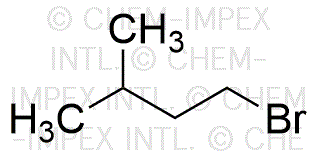1-Bromo-3-methylbutane is widely utilized in research focused on:
- Synthetic Organic Chemistry: This compound serves as a key intermediate in the synthesis of various organic molecules, allowing chemists to create complex structures efficiently.
- Pharmaceutical Development: It is used in the production of pharmaceutical compounds, aiding in the development of new medications by providing a versatile building block for drug synthesis.
- Polymer Chemistry: The compound acts as a reagent in polymerization processes, contributing to the creation of specialized polymers with tailored properties for applications in coatings and adhesives.
- Laboratory Research: Researchers utilize it in various experimental setups to study reaction mechanisms and to develop new chemical methodologies, enhancing the understanding of organic reactions.
- Environmental Chemistry: It is employed in studies related to environmental impact assessments, helping scientists analyze the behavior of organic compounds in different ecosystems.
Informations générales
Propriétés
Sécurité et réglementation
Applications
1-Bromo-3-methylbutane is widely utilized in research focused on:
- Synthetic Organic Chemistry: This compound serves as a key intermediate in the synthesis of various organic molecules, allowing chemists to create complex structures efficiently.
- Pharmaceutical Development: It is used in the production of pharmaceutical compounds, aiding in the development of new medications by providing a versatile building block for drug synthesis.
- Polymer Chemistry: The compound acts as a reagent in polymerization processes, contributing to the creation of specialized polymers with tailored properties for applications in coatings and adhesives.
- Laboratory Research: Researchers utilize it in various experimental setups to study reaction mechanisms and to develop new chemical methodologies, enhancing the understanding of organic reactions.
- Environmental Chemistry: It is employed in studies related to environmental impact assessments, helping scientists analyze the behavior of organic compounds in different ecosystems.
Documents
Fiches de données de sécurité (FDS)
La FDS fournit des informations de sécurité complètes sur la manipulation, le stockage et l’élimination du produit.
Spécifications du produit (PS)
Le PS fournit une description complète des propriétés du produit, notamment sa composition chimique, son état physique, sa pureté et les exigences de stockage. Il détaille également les plages de qualité acceptables et les applications prévues du produit.
Certificats d'analyse (COA)
Recherchez des certificats d'analyse (COA) en saisissant le numéro de lot du produit. Les numéros de lot et de lot se trouvent sur l'étiquette d'un produit, après les mots « Lot » ou « Lot de fabrication ».
Numéro de catalogue
Numéro de lot/série
Certificats d'origine (COO)
Ce certificat d'exploitation confirme le pays dans lequel le produit a été fabriqué, et détaille également les matériaux et composants utilisés et s'il est issu de sources naturelles, synthétiques ou autres sources spécifiques. Ce certificat peut être requis pour les douanes, le commerce et la conformité réglementaire.
Numéro de catalogue
Numéro de lot/série
Fiches de données de sécurité (FDS)
La FDS fournit des informations de sécurité complètes sur la manipulation, le stockage et l’élimination du produit.
DownloadSpécifications du produit (PS)
Le PS fournit une description complète des propriétés du produit, notamment sa composition chimique, son état physique, sa pureté et les exigences de stockage. Il détaille également les plages de qualité acceptables et les applications prévues du produit.
DownloadCertificats d'analyse (COA)
Recherchez des certificats d'analyse (COA) en saisissant le numéro de lot du produit. Les numéros de lot et de lot se trouvent sur l'étiquette d'un produit, après les mots « Lot » ou « Lot de fabrication ».
Numéro de catalogue
Numéro de lot/série
Certificats d'origine (COO)
Ce certificat d'exploitation confirme le pays dans lequel le produit a été fabriqué, et détaille également les matériaux et composants utilisés et s'il est issu de sources naturelles, synthétiques ou autres sources spécifiques. Ce certificat peut être requis pour les douanes, le commerce et la conformité réglementaire.


